Have The Fundamentals Changed?
Although there are lots of folks wringing their hands over last week's dance to the downside in both stock and bond prices, the key question from a macro standpoint is, has anything changed?
Cutting to the chase, I'm going to say, maybe.
Before I get into the details, let's look at some of the reasons/excuses given for last week's shellacking in stocks. First, everyone should be able to admit that the table had been set nicely for the bears to come out of hibernation at some point. The major stock market indices were experiencing the longest stretch in history without a pullback of either 0.6% or 3.0% from the top. So, to say that stocks were extremely overbought is an understatement.
Next, investor sentiment had reached extreme levels as indicators I follow showed optimism to be at the highest levels on record.
Then there is the issue of valuations. Given that the S&P 500 had spiked nearly 18.5% since the August low - thanks in large part to the expectations of tax reform - the traditional stock market valuations (P/E, P/D, P/B) found themselves at bubbly high levels. In short, prices were moving up faster than earnings.
Speaking of earnings, let's remember that for many, the reports from Apple (NASDAQ: AAPL) and Google, err, Alphabet (NASDAQ: GOOGL) fell into the "disappointment" camp.
Next up is the idea that the Fed is, or may soon be, behind the curve in terms of monetary policy and QT (quantitative tightening). By now, everybody knows that the economy is moving ahead at a nice clip. However, the concern is that things may suddenly be moving too fast. For example, last week's GDPNow model from the Atlanta Fed suggests the economy is currently growing at a rate above 5%. And the wage inflation component of the Jobs Report came in at 2.9%, which didn't go unnoticed by economists and bond traders.
To be sure, bond traders were in focus last week as the yield on the U.S. 10-Year spiked to 2.854%. To put this in context, the yield began 2018 at 2.405%. According to my aging solar calculator, that's a move of almost 45 basis points, or 18.7%, in just over a month. And from the recent low point seen back in September, the yield on the 10-year has now advanced 79 basis points, or 38.5%.
To some analysts, the move in the bond market qualifies as a "tantrum." And if one looks back at the last two tantrums seen in the bond market, they will find that the average move in yield from bottom to top was around 130 basis points (source: Ned Davis Research). As such, the bond bears suggest traders have a hall pass to push yields over 3.0% in the near-term.
Getting back to the macro picture, the key here is that the stock market (a) got well ahead of itself and (b) now has to come to grips with the impact of higher rates. And from my seat, unless rates suddenly make a U-turn and head the other way, it may take some time for the market to digest the prospects of a rate environment that looks like it will exceed what had been previously priced in.
The bottom line is this. For some time now, I have opined that risk factors in the stock market have been elevated. And this is what tends to happen in an elevated risk environment. Something comes out of the woodwork (this time it is the spike in rates) to give traders a free pass to panic. But from a big-picture perspective, such moves have a tendency to restore some balance to the market.
While I don't manage money based on my "view" or predictions, at this stage, I believe we are seeing what is likely to wind up being a "garden variety" pullback in stocks. And at least for now, my primary cycle indicators agree with this view.
However, in this business, it is critical to keep your eyes and your mind open to new developments. So, we will repeat this macro exercise at the same time next week and see where we are.
Thought For The Day:
Man does not live by words alone, despite the fact that sometimes he has to eat them. -Adlai Stevenson
Wishing you green screens and all the best for a great day,

David D. Moenning
Founder, Chief Investment Officer Heritage Capital Research
Serving Financial Advisors since 1989
Serving individual investors since 1980
Quesitons, comments, or ideas? Contact Us
Disclosure: At the time of publication, Mr. Moenning held long positions in the following securities mentioned: GOOGL. Note that positions may change at any time.
The State of the Big-Picture Market Models
It's a new week, so let's start things off with a review of the state of my favorite big-picture market models, which are designed to tell us which team is in control of the prevailing major trend.
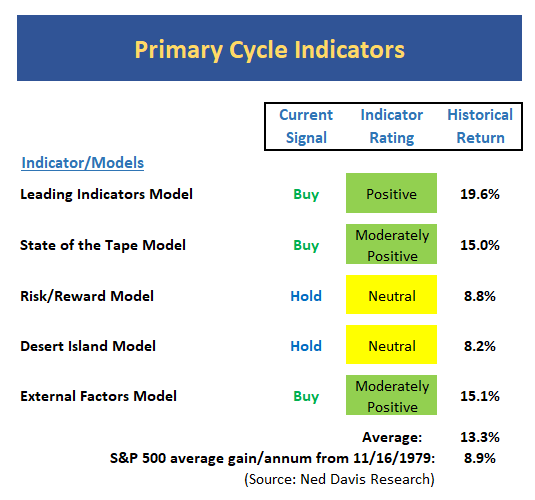
View My Favorite Market Models Online
Executive Summary:
- The Leading Indicators model, which is long-term oriented, has pulled back a bit but remains positive. So far, so good here.
- Ditto for the State of the Tape Model... The current reading remains moderately positive.
- The Risk/Reward model remains neutral. Recall that I've been suggesting for some time that this model represented a big-picture warning that risk levels were elevated.
- My "desert island" model, which is a combination of internal and external factors, remains on a long-term buy signal, but the model reading is currently neutral.
- The newly expanded External Factors model continues to sit right on the line between neutral and moderately positive
- The message from the Primary Cycle board is this remains a bull market. Remember, corrections - sometimes even nasty corrections - are normal.
The State of the Trend
Digging into the details, I like to start my weekly review with a look at the "state of the trend." These indicators are designed to give us a feel for the overall health of the current short- and intermediate-term trend models.
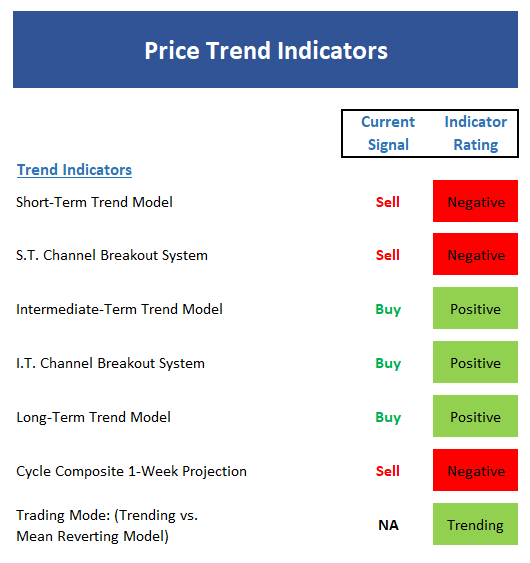
View Trend Indicator Board Online
Executive Summary:
- The short-term trend of the market is now down. The 5-day is below the 10- and 18-day mas, and the trend of the 5-day is down.
- The short-term Channel Breakout system (a modified version of Donchian Channel) produced a sell signal on Friday.
- The intermediate-term trend of the market remains positive. A weekly close below 2700 on the S&P 500 would become problematic.
- The intermediate-term Channel Breakout System remains positive. To start the week, a move below 2673 would trigger a sell signal.
- The long-term Trend Model continues positive. Remember, since 3/13/1957, the S&P 500 has gained at a rate of 10.0% per year when the model is in this mode vs. 7.1% per year for buy-and-hold and -3.6% per year when the model is on a sell signal.
- The Cycle Composite turns red this week and then sideways the next. It appears that the market may be getting back "in tune" with the cycle projection. Stay tuned.
- From an intermediate-term perspective, the market remains in a "trending" mode. While, it will take more than a few days of shelling for the mode to officially change, it is a safe bet that a trading range is likely to develop.
The State of Internal Momentum
Next up are the momentum indicators, which are designed to tell us whether there is any "oomph" behind the current trend.
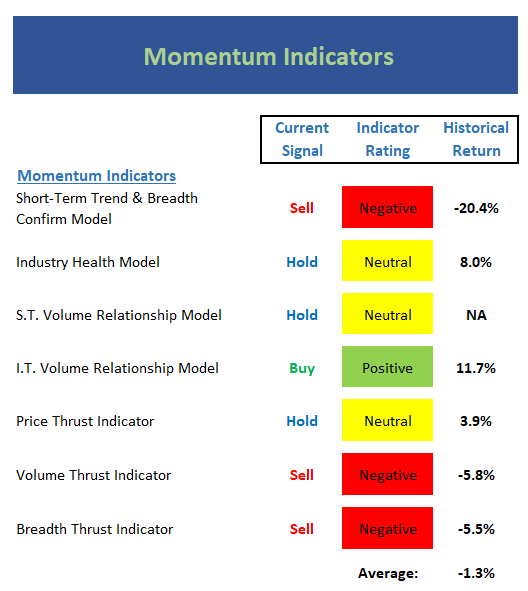
View Momentum Indicator Board Online
Executive Summary:
- The short-term Trend and Breadth Confirm Model flipped to negative for the first time in a long time.
- After spending two weeks in positive territory (albeit by the skinniest of margins), the Industry Health model slipped to neutral last week. And while the ROC of the model reading is now lower, the outright reading is still in decent shape.
- The short-term Volume Relationship pulled back to the neutral zone last week as down volume swamped up volume.
- However, the intermediate-term Volume Relationship Model remains in good shape at this stage of the game.
- As you'd expect, the Price Thrust Indicator slipped into the neutral zone last week.
- The Volume Thrust Indicator, which had been stubbornly neutral of late, moved into the red last week.
- The Breadth Thrust Indicator continued to falter last week, falling to a negative reading.
- The bottom line for the momentum board is the market internals have quickly come off their extremely positive readings. Note that the historical return for the current model readings is negative.
The State of the "Trade"
We also focus each week on the "early warning" board, which is designed to indicate when traders might start to "go the other way" -- for a trade.
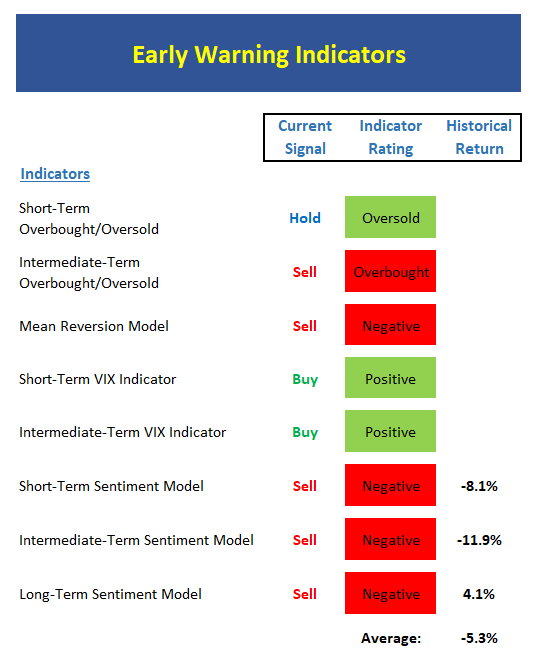
View Early Warning Indicator Board Online
Executive Summary:
- From a near-term perspective, stocks are quickly approaching an oversold reading. However, to get a buy signal, the reading must first get into oversold territory (check) and then reverse.
- From an intermediate-term view, stocks are quickly working off what had been a VERY overbought. Recall that the 40-day RSI reading on the NYSE had been at the highest level seen since 2000.
- To be sure, the Mean Reversion Model has been out of sync with the market. And from my seat, the current sell signal looks late. But, time will tell.
- The short-term VIX indicator remains a buy signal. However, we must recognize that volatility signals are based on mean-reverting strategies, which are clearly out of whack at the present time. For me, the key is to watch the absolute level of volatility. The current reading is the highs seen since October 2016.
- To be sure, the current relationship between the VIX and the stock market is a bit odd and I don't believe there is much "predictive" value provided by the VIX indicators at this time. The message appears to be that traders expect volatility to be higher going forward. Not helpful.
- From a short-term perspective, the market sentiment model recently reached the extreme zone and then reversed. This represents a classic sell signal. Note that the extreme optimism reading has not been worked off yet. However, after last week, I'd expect to see this model flip to green in short order.
- The intermediate-term Sentiment Model remains entrenched in negative territory.
- The Longer-term Sentiment models reached the most negative reading ever and has now reversed. This represents a strong sell signal from an intermediate-term perspective.
The State of the Macro Picture
Now let's move on to the market's "external factors" - the indicators designed to tell us the state of the big-picture market drivers including monetary conditions, the economy, inflation, and valuations.
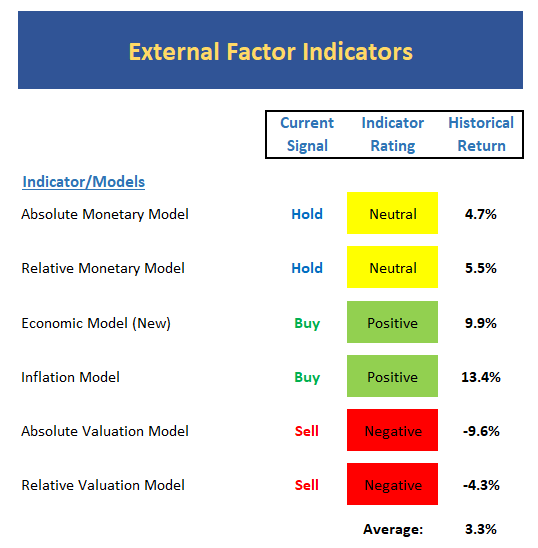
View External Factors Indicator Board Online
Executive Summary:
- Although our Absolute Monetary model remains neutral, the move in rates has pushed the model reading close to a sell signal.
- Ditto for the Relative Monetary Model. Note that this model is quickly approaching the negative zone where stocks have historically lost ground.
- Our Economic Model continues to suggest a strong economic environment.
- The Inflation Model remains positive, but as I've been saying, the reading of the model is starting to move back toward the neutral zone. And since inflation remains a key ingredient to this market narrative, I will continue to watch this model very closely. But for now, inflationary pressures are not overly high.
- As I expected, the Absolute Valuation Model reading spiked to a new cycle high when January's spike in stock prices are factored in.
- Our Relative Valuation Model (which incorporates the current level of interest rates) flashed a new sell signal three weeks ago and is now at its lowest level since 2009.
- I'm going to repeat what I said last week. The takeaway from the External Factors board is the historical return for the current environment is well below normal.
Sample Tactical Allocation Model
Below is an EXAMPLE (and ONLY an EXAMPLE) of how one might incorporate the indicator boards. The approach shown below is designed to provide the current equity allocation for a balanced tactical asset allocation model with a base target of 60/40 stocks/bonds.
The overall intent of the model is to keep equity exposure in line with current conditions.
Beginning February 2018, the model will be updated monthly.
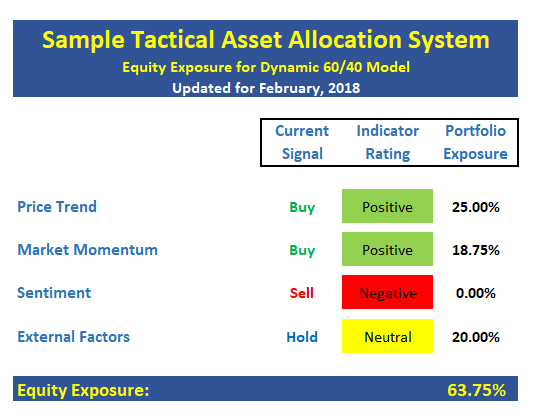
The model above is for illustrative and informational purposes only and does not in any way represent any investment recommendation. The model is merely a sample of how indicators can be grouped to create a guide to market exposure based on the inputs from multiple indicators/models.
Indicators Explained
Short-Term Trend-and-Breadth Signal Explained: History shows the most reliable market moves tend to occur when the breadth indices are in gear with the major market averages. When the breadth measures diverge, investors should take note that a trend reversal may be at hand. This indicator incorporates NDR's All-Cap Dollar Weighted Equity Series and A/D Line. From 1998, when the A/D line is above its 5-day smoothing and the All-Cap Equal Weighted Equity Series is above its 25-day smoothing, the equity index has gained at a rate of +32.5% per year. When one of the indicators is above its smoothing, the equity index has gained at a rate of +13.3% per year. And when both are below, the equity index has lost +23.6% per year.
Channel Breakout System Explained: The short-term and intermediate-term Channel Breakout Systems are modified versions of the Donchian Channel indicator. According to Wikipedia, "The Donchian channel is an indicator used in market trading developed by Richard Donchian. It is formed by taking the highest high and the lowest low of the last n periods. The area between the high and the low is the channel for the period chosen."
Intermediate-Term Trend-and-Breadth Signal Explained: This indicator incorporates NDR's All-Cap Dollar Weighted Equity Series and A/D Line. From 1998, when the A/D line is above its 45-day smoothing and the All-Cap Equal Weighted Equity Series is above its 45-day smoothing, the equity index has gained at a rate of +17.6% per year. When one of the indicators is above its smoothing, the equity index has gained at a rate of +6.5% per year. And when both are below, the equity index has lost -1.3% per year.
Industry Health Model Explained: Designed to provide a reading on the technical health of the overall market, Big Mo Tape takes the technical temperature of more than 100 industry sectors each week. Looking back to early 1980, when the model is rated as "positive," the S&P has averaged returns in excess of 23% per year. When the model carries a "neutral" reading, the S&P has returned over 11% per year. But when the model is rated "negative," stocks fall by more than -13% a year on average.
Cycle Composite Projections: The cycle composite combines the 1-year Seasonal, 4-year Presidential, and 10-year Decennial cycles. The indicator reading shown uses the cycle projection for the upcoming week.
Trading Mode Indicator: This indicator attempts to identify whether the current trading environment is "trending" or "mean reverting." The indicator takes the composite reading of the Efficiency Ratio, the Average Correlation Coefficient, and Trend Strength models.
Volume Relationship Models: These models review the relationship between "supply" and "demand" volume over the short- and intermediate-term time frames.
Price Thrust Model Explained: This indicator measures the 3-day rate of change of the Value Line Composite relative to the standard deviation of the 30-day average. When the Value Line's 3-day rate of change have moved above 0.5 standard deviation of the 30-day average ROC, a "thrust" occurs and since 2000, the Value Line Composite has gained ground at a rate of +20.6% per year. When the indicator is below 0.5 standard deviation of the 30-day, the Value Line has lost ground at a rate of -10.0% per year. And when neutral, the Value Line has gained at a rate of +5.9% per year.
Volume Thrust Model Explained: This indicator uses NASDAQ volume data to indicate bullish and bearish conditions for the NASDAQ Composite Index. The indicator plots the ratio of the 10-day total of NASDAQ daily advancing volume (i.e., the total volume traded in stocks which rose in price each day) to the 10-day total of daily declining volume (volume traded in stocks which fell each day). This ratio indicates when advancing stocks are attracting the majority of the volume (readings above 1.0) and when declining stocks are seeing the heaviest trading (readings below 1.0). This indicator thus supports the case that a rising market supported by heavier volume in the advancing issues tends to be the most bullish condition, while a declining market with downside volume dominating confirms bearish conditions. When in a positive mode, the NASDAQ Composite has gained at a rate of +38.3% per year, When neutral, the NASDAQ has gained at a rate of +13.3% per year. And when negative, the NASDAQ has lost at a rate of -8.5% per year.
Breadth Thrust Model Explained: This indicator uses the number of NASDAQ-listed stocks advancing and declining to indicate bullish or bearish breadth conditions for the NASDAQ Composite. The indicator plots the ratio of the 10-day total of the number of stocks rising on the NASDAQ each day to the 10-day total of the number of stocks declining each day. Using 10-day totals smooths the random daily fluctuations and gives indications on an intermediate-term basis. As expected, the NASDAQ Composite performs much better when the 10-day A/D ratio is high (strong breadth) and worse when the indicator is in its lower mode (weak breadth). The most bullish conditions for the NASDAQ when the 10-day A/D indicator is not only high, but has recently posted an extreme high reading and thus indicated a thrust of upside momentum. Bearish conditions are confirmed when the indicator is low and has recently signaled a downside breadth thrust. In positive mode, the NASDAQ has gained at a rate of +22.1% per year since 1981. In a neutral mode, the NASDAQ has gained at a rate of +14.5% per year. And when in a negative mode, the NASDAQ has lost at a rate of -6.4% per year.
Short-Term Overbought/sold Indicator: This indicator is the current reading of the 14,1,3 stochastic oscillator. When the oscillator is above 80 and the %K is above the %D, the indicator gives an overbought reading. Conversely, when the oscillator is below 20 and %K is below its %D, the indicator is oversold.
Intermediate-Term Overbought/sold Indicator: This indicator is a 40-day RSI reading. When above 57.5, the indicator is considered overbought and when below 45 it is oversold.
Mean Reversion Model: This is a diffusion model consisting of five indicators that can produce buy and sell signals based on overbought/sold conditions.
VIX Indicator: This indicator looks at the current reading of the VIX relative to standard deviation bands. When the indicator reaches an extreme reading in either direction, it is an indication that a market trend could reverse in the near-term.
Short-Term Sentiment Indicator: This is a model-of-models composed of 18 independent sentiment indicators designed to indicate when market sentiment has reached an extreme from a short-term perspective. Historical analysis indicates that the stock market's best gains come after an environment has become extremely negative from a sentiment standpoint. Conversely, when sentiment becomes extremely positive, market returns have been subpar.
Intermediate-Term Sentiment Indicator: This is a model-of-models composed of 7 independent sentiment indicators designed to indicate when market sentiment has reached an extreme from an intermediate-term perspective. Historical analysis indicates that the stock market's best gains come after an environment has become extremely negative from a sentiment standpoint. Conversely, when sentiment becomes extremely positive, market returns have been subpar.
Long-Term Sentiment Indicator: This is a model-of-models composed of 6 independent sentiment indicators designed to indicate when market sentiment has reached an extreme from a long-term perspective. Historical analysis indicates that the stock market's best gains come after an environment has become extremely negative from a sentiment standpoint. Conversely, when sentiment becomes extremely positive, market returns have been subpar.
Absolute Monetary Model Explained: The popular cliché, "Don't fight the Fed" is really a testament to the profound impact that interest rates and Fed policy have on the market. It is a proven fact that monetary conditions are one of the most powerful influences on the direction of stock prices. The Absolute Monetary Model looks at the current level of interest rates relative to historical levels and Fed policy.
Relative Monetary Model Explained: The "relative" monetary model looks at monetary indicators relative to recent levels as well as rates of change and Fed Policy.
Economic Model Explained: During the middle of bull and bear markets, understanding the overall health of the economy and how it impacts the stock market is one of the few truly logical aspects of the stock market. When our Economic model sports a "positive" reading, history (beginning in 1965) shows that stocks enjoy returns in excess of 21% per year. Yet, when the model's reading falls into the "negative" zone, the S&P has lost nearly -25% per year. However, it is vital to understand that there are times when good economic news is actually bad for stocks and vice versa. Thus, the Economic model can help investors stay in tune with where we are in the overall economic cycle.
Inflation Model Explained: They say that "the tape tells all." However, one of the best "big picture" indicators of what the market is expected to do next is inflation. Simply put, since 1962, when the model indicates that inflationary pressures are strong, stocks have lost ground. Yet, when inflationary pressures are low, the S&P 500 has gained ground at a rate in excess of 13%. The bottom line is inflation is one of the primary drivers of stock market returns.
Valuation Model Explained: If you want to get analysts really riled up, you need only to begin a discussion of market valuation. While the question of whether stocks are overvalued or undervalued appears to be a simple one, the subject is extremely complex. To simplify the subject dramatically, investors must first determine if they should focus on relative valuation (which include the current level of interest rates) or absolute valuation measures (the more traditional readings of Price/Earnings, Price/Dividend, and Price/Book Value). We believe that it is important to recognize that environments change. And as such, the market's focus and corresponding view of valuations are likely to change as well. Thus, we depend on our Valuation Models to help us keep our eye on the ball.
Disclosures
The opinions and forecasts expressed herein are those of Mr. David Moenning and may not actually come to pass. Mr. Moenning's opinions and viewpoints regarding the future of the markets should not be construed as recommendations. The analysis and information in this report is for informational purposes only. No part of the material presented in this report is intended as an investment recommendation or investment advice. Neither the information nor any opinion expressed constitutes a solicitation to purchase or sell securities or any investment program.
Any investment decisions must in all cases be made by the reader or by his or her investment adviser. Do NOT ever purchase any security without doing sufficient research. There is no guarantee that the investment objectives outlined will actually come to pass. All opinions expressed herein are subject to change without notice. Neither the editor, employees, nor any of their affiliates shall have any liability for any loss sustained by anyone who has relied on the information provided.
Mr. Moenning may at times have positions in the securities referred to and may make purchases or sales of these securities while publications are in circulation. Positions may change at any time.
The analysis provided is based on both technical and fundamental research and is provided "as is" without warranty of any kind, either expressed or implied. Although the information contained is derived from sources which are believed to be reliable, they cannot be guaranteed.
Investments in equities carry an inherent element of risk including the potential for significant loss of principal. Past performance is not an indication of future results.
